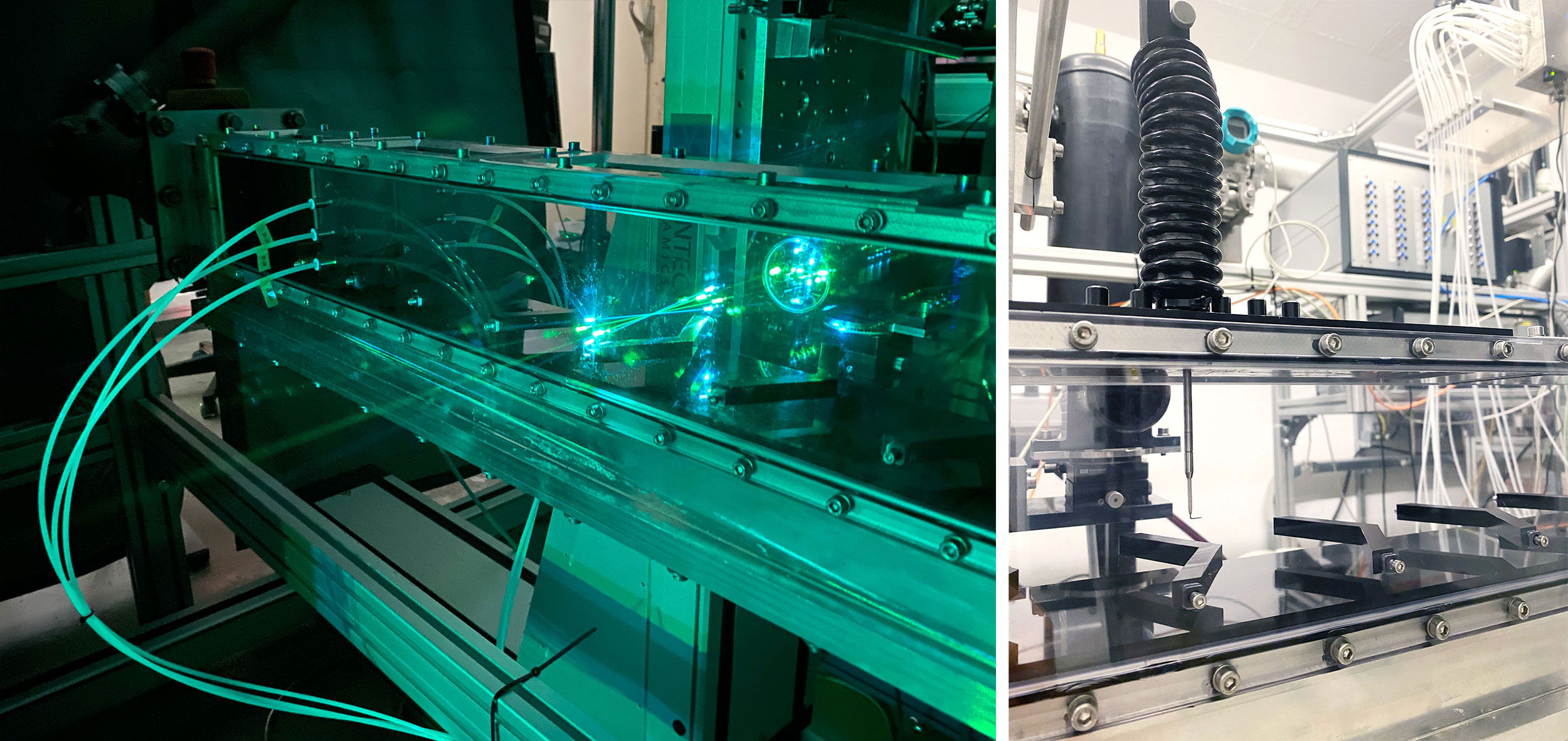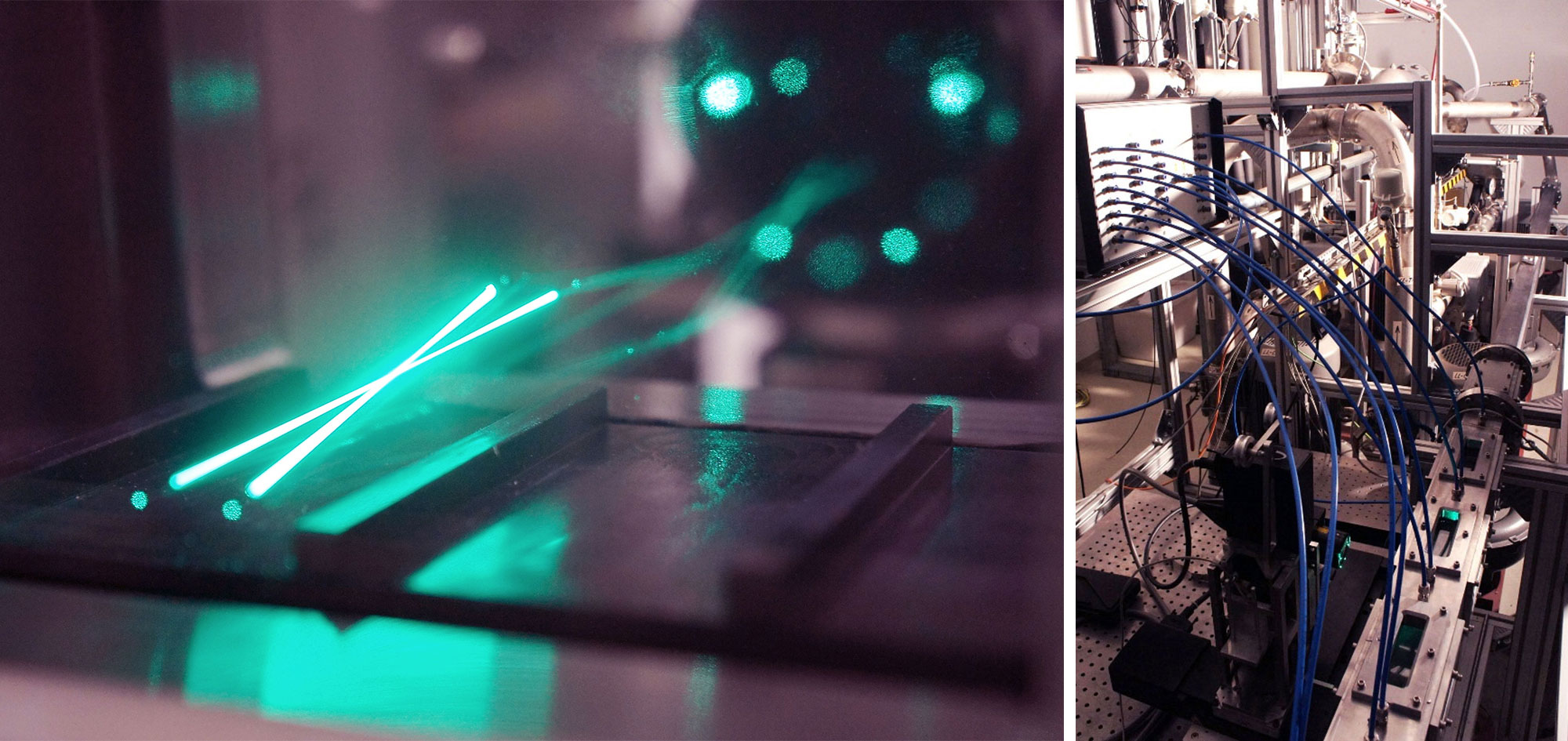Near Wall Flow Adaption for Heat Transfer Enhancement
The application of surface structures to enhance convective heat transfer is a proven method to enable high heat flux densities and high working fluid temperatures within the material-specific temperature ranges in heat exchangers and power plant components such as air-cooled gas turbine blades, solar receivers or high-temperature reactor components. Depending on the thermal operation mode of the component, improved heat transfer leads to an accelerated change in adiabatic mixing temperature or a reduction in component material temperature and material temperature gradients. Thus, the heat transfer surface can be reduced, the thermal system efficiency can be improved, the component life can be extended, or the load flexibility can be increased. Compared to other surface structures, rib surface structures can enhance the heat transfer enormously and, therefore, provide an effective cooling of thermally highly loaded component walls in thermal engineering components.
The enhancement of convective heat transfer is based on turbulent and advective flow processes within the near-surface flow region. Depending on the geometrical configuration, the rib strcutres determines the near-surface flow topology in different ways by unsteady vortex shedding processes, free shear layer flows in the wake of the surface structures and recirculation flows, and large-scale secondary flows. Different research projects in the field of near-wall structure design for highly efficient thermal mixing is carried out in the ASS group.
DFG- RU 2264/2-1: Effects of detached V-shaped ribs on turbulent flow and temperature fields, heat transfer and drag coefficient in cooling channels
Rib-roughening fluid-solid interfaces is an appropriate method for designing thermally effective heat-exchanger components. Structured surfaces enable the transfer of high heat flux rates between a coolant and the heated wall within the structural material temperature limits of heat exchangers. The objective of the present research project is the investigation of effects of rib-induced turbulent flow structures on heat transfer and flow resistance in a square channel rib-roughened by detached 60° V-shaped ribs on one channel wall for varying geometrical parameters and thermal-hydraulic conditions.
The state of the art showed that the application of attached 60° V-shaped ribs causes efficient heat transfer enhancement. Rib-induced secondary flow motion increases the vertical mean flow velocity yielding enhanced convective heat transfer and high turbulent mixing. However, flow stagnation zones with deteriorated heat transfer occur in the vicinity of the concave rib-corners and in the recirculation regions of attached ribs. By detaching ribs from the wall, local heat transfer deterioration can be reduced. The displacement of the ribs from the wall induces a gap flow beneath the ribs. The flow exits the gap like a wall-jet flow and interacts with the wake flow. Thus, flow stagnation regions and the accompanied local heat transfer deterioration are minimized. It is assumed that the combination of these both favored attributes, i.e. that the application of detached 60° V-shaped ribs leads to increased thermal mixing, homogeneous solid-fluid surface temperature and enhanced local and global heat transfer and, thus, to a more effective performance than provided by attached ribs.

Fig. 1. Laser-Doppler-Anemometry and hotwire flow velocity measurements in a square channel rib-roughened by detached 60° V-shaped ribs.
Publications
- Ruck, S., Arbeiter, F., Digel, L., Lorenzo Mercado, I., LDA-Messungen entlang V-förmiger angehobener Rippen in einem quadratischen Kanal, Laser Methods in Flow Measuring Technique (2022)
- Ruck, S., Arbeiter, F., Brenneis, B., Wund, H., Effects of the streamwise extent of periodic computational domains on turbulent flow and heat transfer in rib-roughened cooling channels, Proceedings 14th International Conference on Heat Transfer, Fluid Mechanics and Thermodynamics, Wicklow, Ireland (2019).
Validation database for structured surfaces in square channels
Scale-resolved flow simulations, hybrid RANS/LES approaches, and RANS with higher-order turbulence models are increasingly used to design surface structures and ribs for use in heat exchangers to enhance convective heat transfer allowing simultaneous calculation (CFD) of the turbulent velocity and temperature fields. Depending on the numerical approach, turbulence or small-scale model, computational domain configuration, and boundary conditions, the results of simulation methods vary when calculating flows near walls with rib-roughened surface structures. Moreover, studies show that standard turbulence models based on eddy viscosity models and the Reynolds analogy are not able to calculate the turbulent velocity and temperature fields with sufficient accuracy. Accordingly, the application of computational fluid dynamics as a design tool for rib surface structures requires extensive validation as well as application strategies.

Fig. 2. LDA measurements and pressure drop measurements in the AEROLAS facility for validation and quantification of uncertainties of CFD applications in turbulent channel flows.
A dataset of LDA measurements in a one-sided ribbed square channel at Reynolds numbers of 50 000 and 100 000 can be found here.
Publications
- Ruck, S., Arbeiter, F., Measurements of Turbulent Transport in a Square Channel With One Ribbed Wall, Journal of Fluids Engineering, 144(7) (2022) 071304. https://doi.org/10.1115/1.4053442
- Ruck, S., Arbeiter, F., Petri, T., Laser-Doppler-Anemometrie-Messungen in einem quadratischen Kanal mit eng beieinanderliegenden Rippen an einer Wand, tm - Technisches Messen (2022)89(3) 158-167. https://doi.org/10.1515/teme-2021-0121
- Ruck, S., Arbeiter, F., LDA measurements in a one-sided ribbed square channel at Reynolds numbers of 50,000 and 100,000, Experiments in Fluids 62 (2021) 232. https://doi.org/10.1007/s00348-021-03313-5
- Ruck, S., Arbeiter, F., Petri, T., Schlindwein, G., LDA-Messungen in einem einseitig be-rippten Kanal bei Reynolds-Zahlen von Re ≥ 50 000, Laser Methods in Flow Measuring Technique, ISBN978-3-9816764-7-1, 20.1-20.10 (2021).
